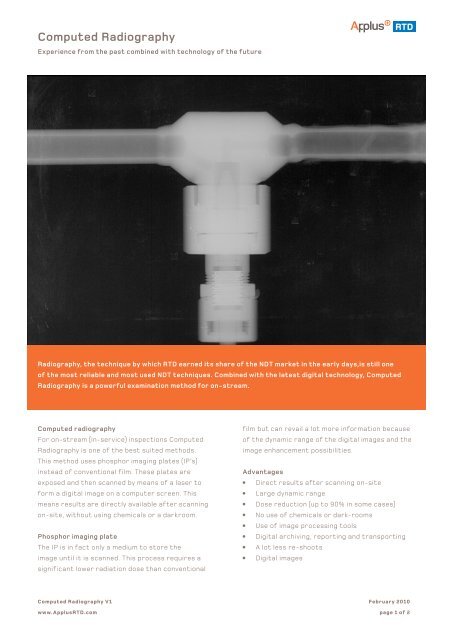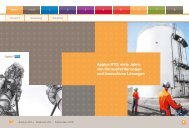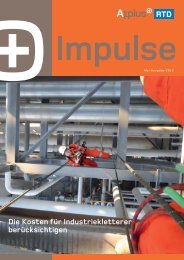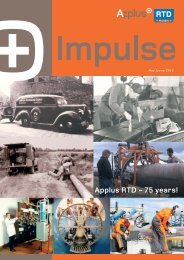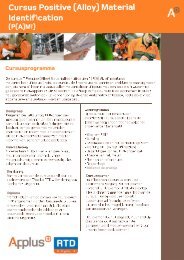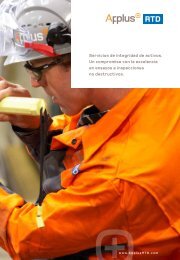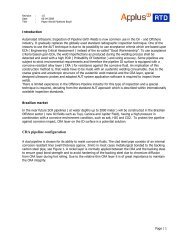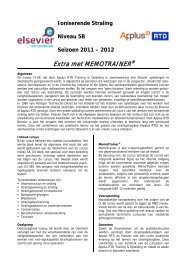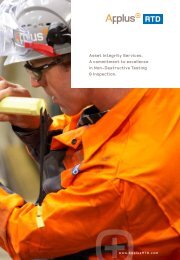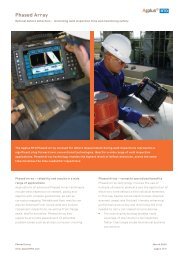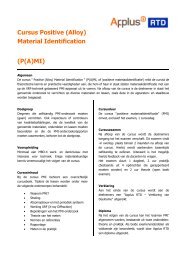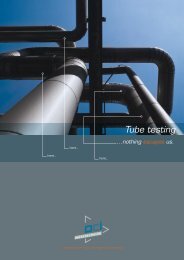Computed Radiography - Applus RTD
Computed Radiography - Applus RTD
Computed Radiography - Applus RTD
You also want an ePaper? Increase the reach of your titles
YUMPU automatically turns print PDFs into web optimized ePapers that Google loves.
<strong>Computed</strong> <strong>Radiography</strong><br />
Experience from the past combined with technology of the future<br />
Fotobijschrift?<br />
<strong>Radiography</strong>, the technique by which <strong>RTD</strong> earned its share of the NDT market in the early days,is still one<br />
of the most reliable and most used NDT techniques. Combined with the latest digital technology, <strong>Computed</strong><br />
<strong>Radiography</strong> is a powerful examination method for on-stream.<br />
<strong>Computed</strong> radiography<br />
For on-stream (in-service) inspections <strong>Computed</strong><br />
<strong>Radiography</strong> is one of the best suited methods.<br />
This method uses phosphor imaging plates (IP’s)<br />
instead of conventional film. These plates are<br />
exposed and then scanned by means of a laser to<br />
form a digital image on a computer screen. This<br />
means results are directly available after scanning<br />
on-site, without using chemicals or a darkroom.<br />
Phosphor imaging plate<br />
The IP is in fact only a medium to store the<br />
image until it is scanned. This process requires a<br />
significant lower radiation dose than conventional<br />
<strong>Computed</strong> <strong>Radiography</strong> V1<br />
w w w.<strong>Applus</strong><strong>RTD</strong>.com<br />
film but can revail a lot more information because<br />
of the dynamic range of the digital images and the<br />
image enhancement possibilities.<br />
Advantages<br />
•<br />
Direct results after scanning on-site<br />
Large dynamic range<br />
Dose reduction (up to 90% in some cases)<br />
No use of chemicals or dark-rooms<br />
Use of image processing tools<br />
Digital archiving, reporting and transporting<br />
A lot less re-shoots<br />
Digital images<br />
February 2010<br />
page 1 of 2
<strong>Computed</strong> <strong>Radiography</strong><br />
Applications<br />
The method is ideal for the following applications:<br />
•<br />
•<br />
Wall thickness measurements<br />
Corrosions assessments (including CUI)<br />
Check on blockages (in case of imperfections I<br />
expect something small)<br />
Insulated pipes and objects<br />
• Art<br />
Computerised interpretation<br />
Since the image is transformed into a digital<br />
format interpretation can be done by means of<br />
a computer. By using image processing tools the<br />
images can be enhanced which leads to a better<br />
and easier interpretation.<br />
<strong>Computed</strong> <strong>Radiography</strong> V1<br />
w w w.<strong>Applus</strong><strong>RTD</strong>.com<br />
February 2010<br />
page 2 of 2


